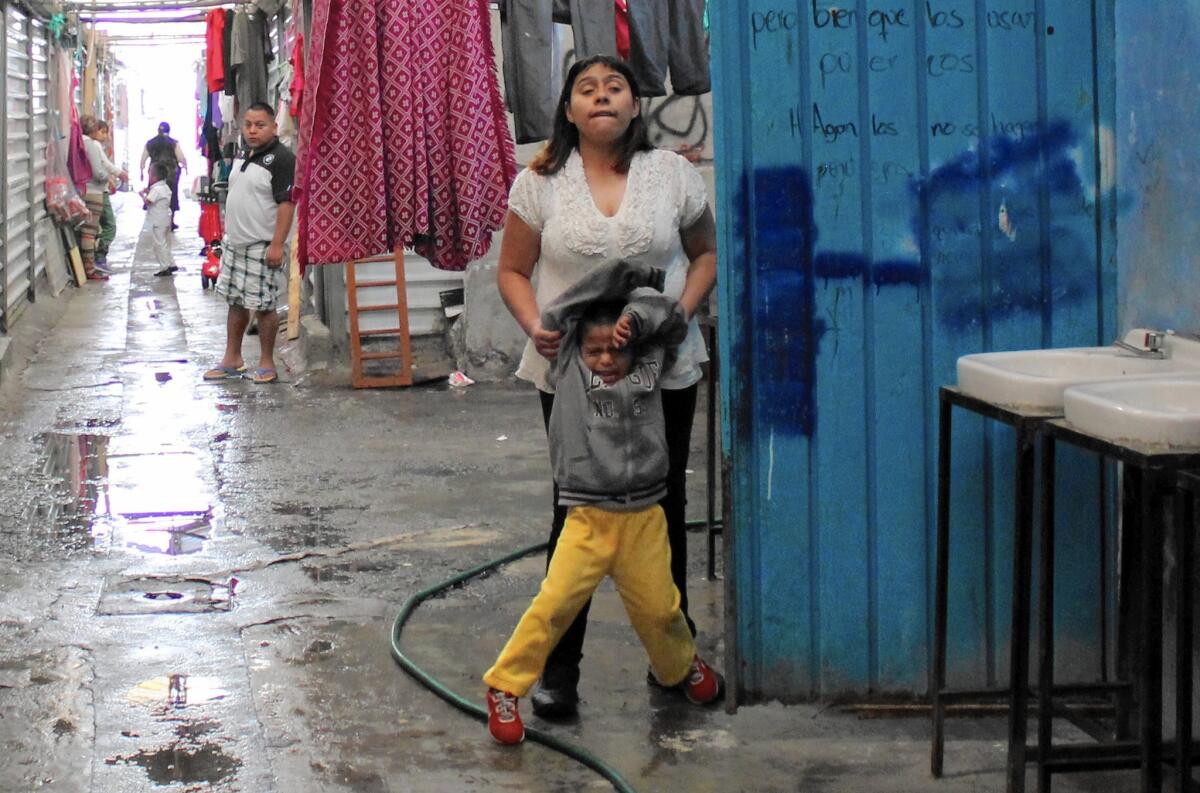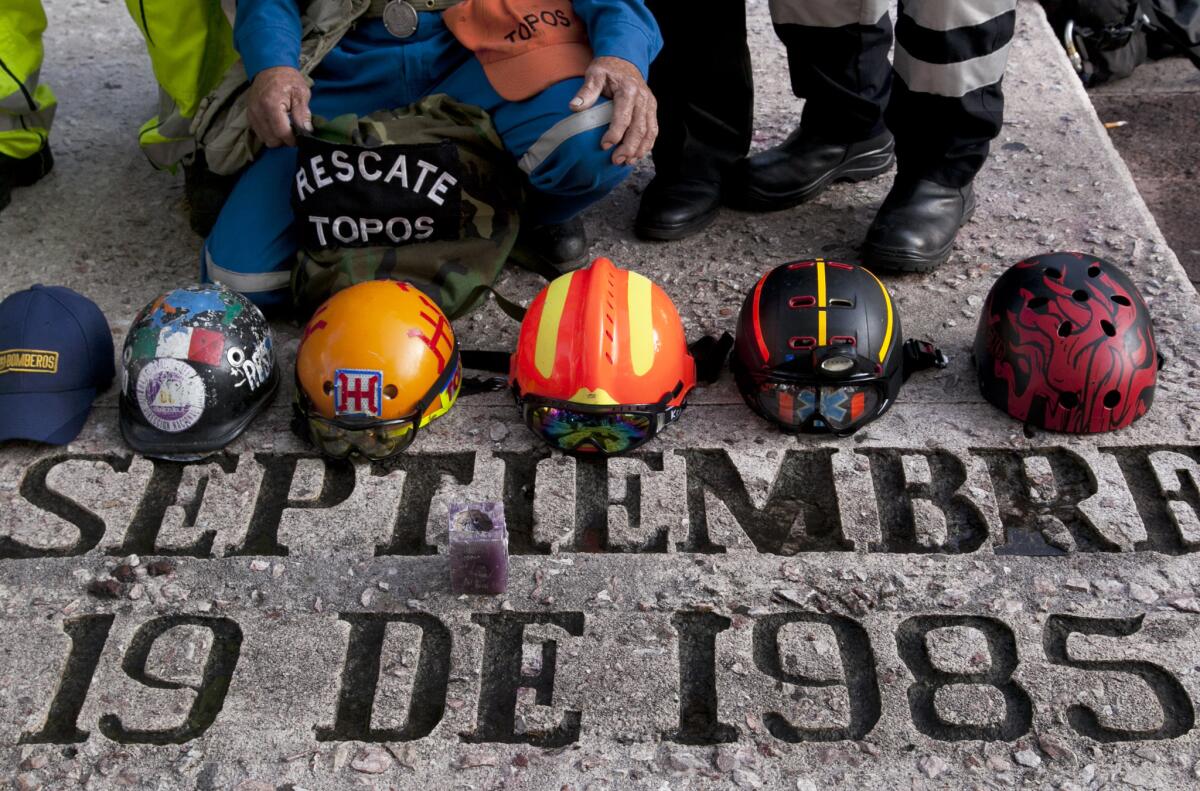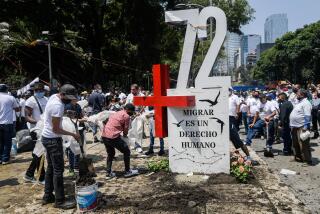30 years after Mexico City quake, hundreds still live in temporary camps

reporting from Mexico City — On the 30th anniversary of the massive Mexico City earthquake, alarms rang out across the city to commemorate the disaster.
But Marcia Vasquez needed no reminder of the Sept. 19 anniversary.
Vasquez, now 52, still lives in the camp she was forced to move to after her apartment caved in three decades ago.
“When I got home and saw everything was destroyed,” she says, “I thought of the people who had been in the building. Children. I could see toys hanging from the ruins. It was horrible.”

Rescue workers’ hats sit on a memorial honoring those who died in the 1985 earthquake on the 30th anniversary in Mexico City.
All of Vasquez’s belongings were lost that day. Pregnant and single at the time, she couldn’t afford to place a deposit and pay rent on another apartment, so she moved into a makeshift camp. She says that when she approached the government for assistance, she was told that she didn’t qualify because she hadn’t been injured, and that she should be grateful to be alive.
The government says 5,000 people died as a result of the magnitude 8 quake that struck at 7:19 a.m. Citizen activist groups say the death toll was closer to 30,000. Most sources agree that about 30,000 people lost their homes that day, and thousands more buildings were seriously damaged and unfit to live in.
NEWSLETTER: Get the day’s top headlines from Times Editor Davan Maharaj >>
Those left without a roof over their heads were known as damnificados — victims — and many of them moved into camps, most of which shut down as inhabitants gradually found replacement housing.
But 30 years later, about 300 families still live in what were then described as temporary settlements in the capital.
For about 20 years Vasquez lived in a tent that she made of plastic sheeting and wooden poles on the edge of a stinking river. Then the city government moved her to her current home in a collection of sheet-metal shacks that house about 70 families.

Marcia Vasquez stands outside her tin shack in one of five temporary camps for victims of the 1985 Mexico City earthquake where the residents are still living 30 years later.
She bore and brought up her three children in the camp, and now lives with her 11-year-old grandson in the 10-by-20-foot space that she says leaks when it rains and heats up like an oven when it is warm.
“This place is better than where I was,” she says, sitting on the double bed in the corner of her home. “In the other place, huge rats would come into the tent and fight at night. I had to build a hammock for my babies so they slept high up and wouldn’t get eaten.”
Now, there are fewer rats and they are much smaller. Vasquez has pushed cheap bright pink soap into the holes in her roof to prevent rain from coming in. She has a small standing stove for cooking, but there is no running water. The floor is concrete.
She says she earns a little money each month cleaning houses and mending clothes.
Across the way from Vasquez lives Adriana Garcia, 30. A shabby curtain hangs across her front door, and she reluctantly agrees to be interviewed inside. Wet, clean clothes hang drying on the outside wall of the shack.
Garcia’s mother, Rosalinda, was living in the central Condesa neighborhood when the earthquake struck. Garcia was born two months later, and her mother continued to reside in the same apartment block even though it had been heavily damaged. City authorities insisted that they move out after smaller quakes threatened to bring down the building. Rosalinda died in the camp six years ago.
Garcia and her brother Ernesto, 27, still live in the camp, waiting to be rehoused.
“I get depressed a lot,” says Garcia, who used to work as a shop supervisor but is currently unemployed.
“Why do I have to live like this, I tell myself. I want a better life, but we’ve been waiting [for a new home]. Otherwise we’d have made more of a plan and done something else. It’s the most affordable way for us to get a place.”
When I got home and saw everything was destroyed. I thought of the people who had been in the building. Children. I could see toys hanging from the ruins. It was horrible.
— Marcia Vasquez, Mexico City resident
Not all the residents are victims of the earthquake. Some are relatives who have taken the place of family members who were left homeless by the temblor and either died or moved on.
A few weeks ago, Mexico City Mayor Miguel Angel Mancera ordered the local housing institute, INVI, to close the five remaining camps in the city and to resettle the inhabitants.
INVI Director Raymundo Collins said in an interview that within the next few months all of the camps will be gone. People will be given a rent subsidy of about $175 a month and then moved into new heavily subsidized housing that they will pay off, interest-free, at a rate dependent on their income levels.
There are no figures on how many people left homeless by the quake have already been rehoused by INVI. Many went off the official radar by moving in with family or going to live in other states.
“We can’t say that we’ve made a complete recovery, but there have been very important advances,” said Collins, who hopes the closing of the camps will bring an end to the housing crisis precipitated by the earthquake.
Both Vasquez and Garcia have doubts about whether they will be helped as the government has promised once they leave the camp. They say that they’ve been promised assistance before but not received any. Despite the discomfort of the camp, no one pays rent or for water and electricity, and the prospect of facing those bills is daunting, even if the cost of the rent is government-subsidized.
“I’m scared because I don’t know how it will be,” Vasquez says.
But rather like the earthquake in 1985, change is coming to those in these camps. Whether they like it or not.
Bonello is a special correspondent.
ALSO:
The families of Mexico’s ‘disappeared’ people keep searching
Relatives of 43 missing students in Mexico seek answers one year later
Two of Mexico’s most notorious criminals are in custody in the United States
More to Read
Sign up for Essential California
The most important California stories and recommendations in your inbox every morning.
You may occasionally receive promotional content from the Los Angeles Times.










